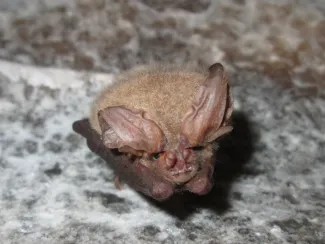Groups of bat biologists and cavers are quietly filtering into Oklahoma’s caves this month to monitor the hibernating bat populations found within.
“We are checking to see which species are using the caves, and how many individual bats are present,” said Melynda Hickman, wildlife diversity biologist for the Oklahoma Department of Wildlife Conservation and member of the Oklahoma Bat Coordinating Team. “Some species of bats like to hibernate in large clusters and are easy to see, but others like to tuck into very small crevices and can be a challenge to find.”

The Western Big-eared Bat
During this winter’s bat surveillance, biologists may encounter up to seven species of hibernating bats, including the western big-eared bat.
As its name suggests, the western big-eared bat has exceptionally large ears. The 1.5-inch-long ears are in fact one-third of the total body length and are used during echolocation. Big-eared bats also have two distinctive glandular lumps between the nostril and the eye.
A cave-dweller, the western big-eared bat prefers western Oklahoma’s cool, damp gypsum caves. They have also been found in caverns under granite boulders in the Wichita Mountains.
The western big-eared bat is one of two Townsend’s big-eared bat subspecies. The second subspecies, the Ozark big-eared bat, is found in three counties in northeastern Oklahoma and is listed as federally endangered.
Counts are conducted within a few hours, depending on the size of the individual cave. “At the end of the count, we tally the number of bats detected, and compare it to previous years,” said Hickman. “It gives us a look at how the wintering populations vary year to year, with minimal disturbance to the bats.”
These wintertime counts also provide an opportunity to inspect the bats for white-nose syndrome, a disease that affects hibernating bats. To sample for the disease, biologists run a small swab over the bat’s forearm and around their muzzle. Each year, samples are taken from select caves in eastern and western Oklahoma. The swabs are sent to either a laboratory in New Mexico or the U.S. Geological Service’s National Wildlife Health Center in Wisconsin where they join samples from across the nation to be tested for the disease. To date, 26 states have been affected by whit-nose syndrome.
In May 2015, three of the samples taken from a Delaware County, Oklahoma cave during the 2015 winter surveillance efforts returned positive for the fungus associated with white-nose syndrome. No dead bats were observed in the cave, nor were there any visible signs of the disease on the hibernating bats. “At the time, this finding marked the westernmost case of the fungus in the United States, and the first documentation of the fungus in Oklahoma,” said Hickman. The fungus has since been documented further west, in Cass County, Nebraska.
Because of the Oklahoma finding, researchers from Rogers State University, working on an unrelated bat study, partnered with the USGS to take additional samples from bats captured in June and August 2015. All samples from these summer surveys returned negative for the fungus.